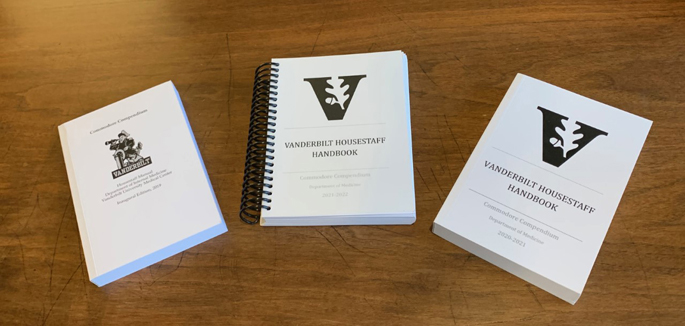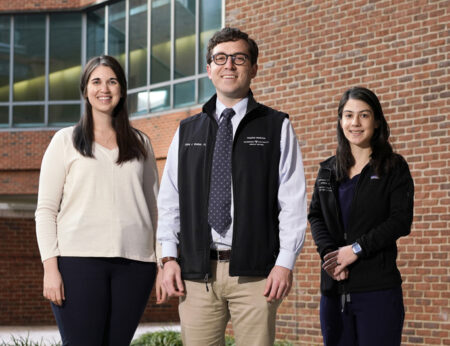
Residency training is an important time in the education of postgraduate medical students, when future doctors are able to step into the role of physician for the first time. The transition from medical student to resident brings unique challenges, which are often best understood by other residents.
These challenges are something Michael Neuss, MD, PhD, understands as someone who completed his residency at VUMC. His residency experience at VUMC meant Neuss was well suited to serve as the first editor-in-chief and later the first faculty lead of a project known as the Vanderbilt internal medicine residency handbook.
The intention behind the handbook was to create a resource that was easy, enjoyable and helpful for residents to use in clinical practice, Neuss says.

“I still consult the handbook, and now I am overjoyed to see it consulted thousands of times on the web each month,” he said. “In retrospect, I did not fully appreciate the extent to which the handbook would become such an enriching educational opportunity for residents.”
Neuss, along with Jennifer Green, MD, PhD, assistant professor of Medicine and Pediatrics and first faculty supervisor for the handbook, led the handbook in its development stages, which involved over 130 contributing authors and editors.
The handbook is now in the hands of Chase Webber, DO, assistant professor of Clinical Medicine, as faculty lead, with Soibhan Kelley, MD, and Jennifer Marvin-Peek, MD, as resident editors-in-chief.
“As physicians we are constantly forming new hypotheses and testing the decisions we make with input from many different data streams,” Webber said.
“It is a major help to have trusted information and evidence resources such as the handbook that go beyond mainstream texts and websites. It is truly an inspiring, coordinated effort, and it has been fascinating to follow its success and evolution particularly during the COVID-19 pandemic.”
Through the handbook’s many stages — from its first edition to its third — the goal has been to provide specific, systems-based guidance on medical practice at VUMC and the Nashville VA. The resident editors-in-chief change every year to ensure the handbook is created by current residents for current residents.
The handbook began as a printed resource that could fit in the pocket of a resident’s white coat, but after finding its way to the internet as an online resource, the handbook’s audience expanded. In addition to being printed 600 times per year, the online edition of the handbook is visited several thousand times per month. Learners and educators at academic medical centers, both nationally and worldwide, frequently turn to the wisdom of residents and faculty at Vanderbilt.
As a current resident editor-in-chief, Marvin-Peek has experienced firsthand the benefits of the handbook as a reference guide, especially when residents are working nights and may not have immediate access to an attending physician.
This year, Marvin-Peek and Kelley will focus on making sure that all handbook sections are updated to reflect new guidelines and literature, adding any missing topics and consolidating sections that may be duplicated. Cameron Hilton, MD, will assist in updating the online version of the handbook to be more user-friendly.
The unwavering support of Kimryn Rathmell, MD, PhD, Hugh J. Morgan Professor and chair of the Department of Medicine, and John McPherson, MD, the Drs. Sol and Marvin Rosenblum Professor of Medicine and director of the Internal Medicine Residency Program in the Department of Medicine, has been vital to the success of the handbook.
“This is an outstanding handbook that I carry in my pocket as well, and the initiative to complete and sustain it shows the resourcefulness of our house staff and the engagement of faculty. This accomplishes key elements of our mission to provide exceptional, personalized care for patients and to train the next generation of leaders in medicine,” said Rathmell.
Other significant contributors to the handbook include C. Alex Wiles, MD, Aseel Alsouqi, MD, and Robert Dunn, MD, who served as resident editors-in-chief of the second edition of the handbook, which was dedicated to William J. Stone, MD, nephrologist and professor of Medicine, emeritus, who spent 50 years as a member of the faculty of the Vanderbilt University School of Medicine.
Leah Brown, MD, and Joseph Quintana, MD, served as resident editors-in-chief of the third edition of the handbook, which was dedicated to the late Pierre Massion, MD, Cornelius Vanderbilt Chair and Professor of Medicine, an internationally known expert on early detection and prevention strategies for lung cancer, and the late Richard Light, MD, professor of Medicine in the Division of Allergy, Pulmonary and Critical Care and a world-renowned expert in pleural disease.












